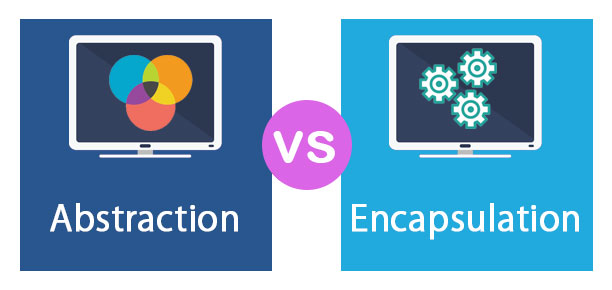Updated July 12, 2023
Difference between Abstraction and Encapsulation
Abstraction vs Encapsulation is the basic object-oriented programming (OOP) concept that allows real objects to be implemented in Code and program. They are very different as they both go hand in hand. Although they are both technically inseparable, they have nothing in common, literally. Almost all encapsulation is an abstraction because they both mask something but have a fair share of differences.
What is Abstraction?
Abstraction is a fundamental OOP concept that focuses only on an object’s pertinent data and covers up all the irrelevant details that can or can not be used for generical or specialized conduct. It masks the background details and highlights the essential elements to reduce complexity and improve efficiency. It helps to simplify the domain model representation. Abstraction is more about ideas than about events. It covers up the details at the design level by offering users functionality. An abstraction may also be called the resulting object.
Let’s take an example.
So let we will consider the motorcycle. A mechanic is attempting to repair your motorcycle or, say, a certain section of your motorcycle. You are the user, and you don’t want to know your motorcycle specifics or what portion has actually broken. You don’t care; you simply want your motorcycle in its original condition without worrying about the details. You told the mechanic what you wanted by separating the implementing part; this is called abstraction. The most important thing you did was fix your motorcycle instead of focusing on the particulars.
What is Encapsulation?
Another concept of OOP encapsulation binds data and functionalities into one component while limiting access to certain components has been established. Encapsulation will improve the maintainability of your application. This will provide the user with a lot of flexibility in using the system. It makes the entire coding process easier, as you are interested only in what a different class does not do. This is one of the main basic concepts of OOP, which wraps data and data into one unit. It gives the data fundamental integrity by defending it from the outside world. It hides additional information from the outside world in easy terms.
Let’s take an example.
Only you need to know the device’s behavior without having to worry about implementing details like what sensors the Keyboard has and whether it is wireless or not etc. Every detail describes the mouse, but it is simply a keyboard, irrespective of the detail. You just have a keyboard interface, which is the mouse pointer in this situation, and this we called Encapsulation.
Head To Head Comparison Between (Infographics)
Below is the top 6 difference between Abstraction and Encapsulation
Key Differences Between Abstraction and Encapsulation
Let us discuss some of the major differences between Abstraction vs Encapsulation:
The main difference between abstraction and encapsulation is that the problem is solved by Abstraction at the design level and the application level by Encapsulation. Abstraction involves hiding unwanted information while providing the most important information, whereas encapsulation implies hiding code and information in one device.
Abstraction allows you to focus on what the item does instead of how it does, while encapsulation means the inner details of how the object is working. You can modify it later with a better technique if you maintain the inner information confidential. Abstraction focuses on outside viewing, for example, shifting the car, while Encapsulation focuses on internal working or inner viewing.
Abstraction is supported in Java with the interface and the abstract class, and Encapsulation is supported using, e.g. public, private and secure access modification systems. This is the separation in Java and OOP among Encapsulation and Abstraction. Recall that abstraction solves the issue at the design level and encapsulation at the execution level. Both for an OOP programmer are very essential, but it can sometimes be hard to explain. As I said before, writing code and reading the code of others are some of the best ways to learn and master object-oriented programming.
Abstraction is hiding implementation with the help of the interface, an abstract class, whereas Encapsulation is hiding the data with the help of getters and setters.
Comparison table of Abstraction vs Encapsulation
Below is the topmost comparison between Abstraction vs Encapsulation:
| Abstraction |
Encapsulation |
| Abstraction works on the design level. | Encapsulation works on the application level. |
| Abstraction is implemented to hide unnecessary data and withdraw relevant data. | Encapsulation is the mechanism of hiding the code and the data together from the outside world or misuse. |
| It highlights what the work of an object instead of how the object works is | It focuses on the inner details of how the object works. Modifications can be done later to the settings. |
| Abstraction focuses on outside viewing, for example, shifting the car. | Encapsulation focuses on internal working or inner viewing, for example, the production of the car. |
| Abstraction is supported in Java with the interface and the abstract class. | Encapsulation is supported using, e.g. public, private, and secure access modification systems. |
| In a nutshell, abstraction is hiding implementation with the help of an interface and an abstract class. | In a nutshell, encapsulation is hiding the data with the help of getters and setters. |
Conclusion
In this article, we have seen what Abstraction vs Encapsulation is and the difference between them. While both are Data Hiding OOP ideas, they are quite distinct from one another. It masks the background information and highlights the critical information points to reduce complexity and improve effectiveness. With new requirements, the encapsulated code is very flexible and easy to change.
Recommended Articles
This has been a guide to the top difference between Abstraction vs Encapsulation. Here we also discuss the key differences between infographics and comparison tables. You may also have a look at the following articles to learn more –


